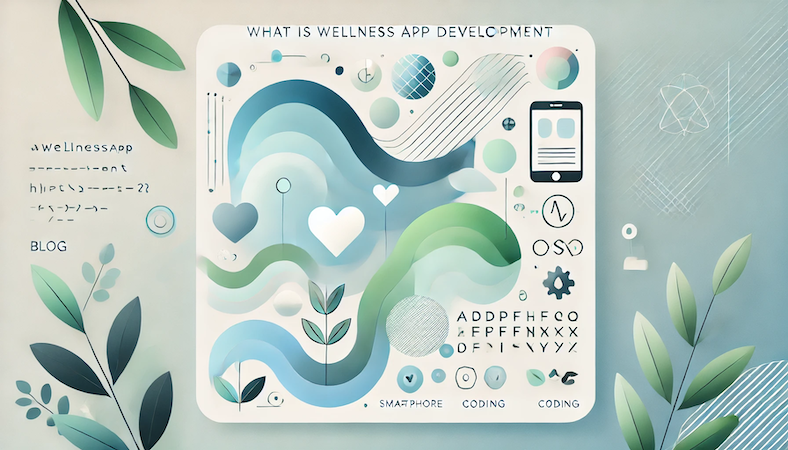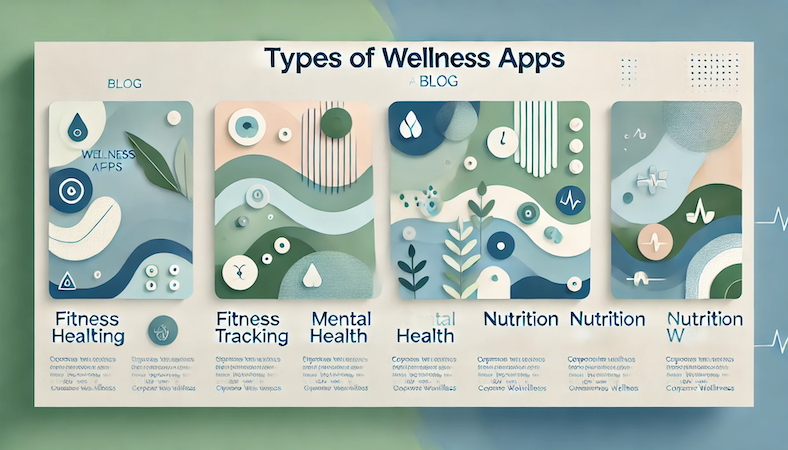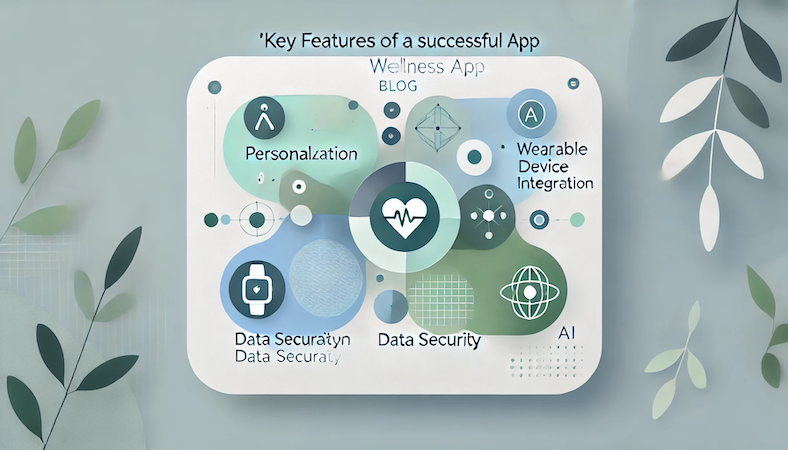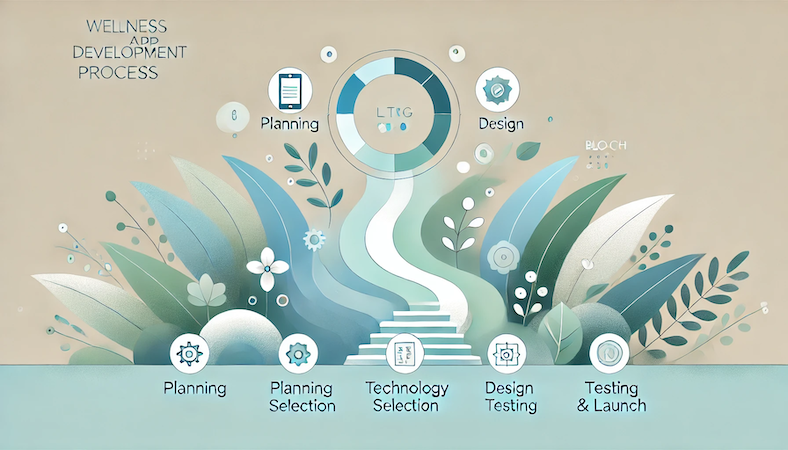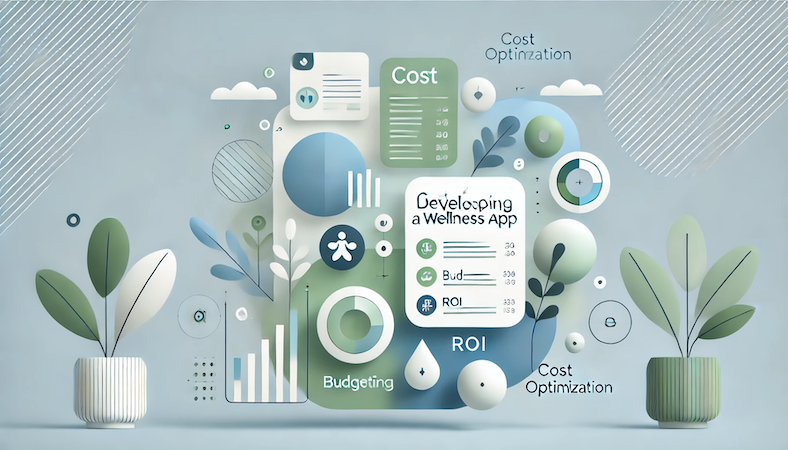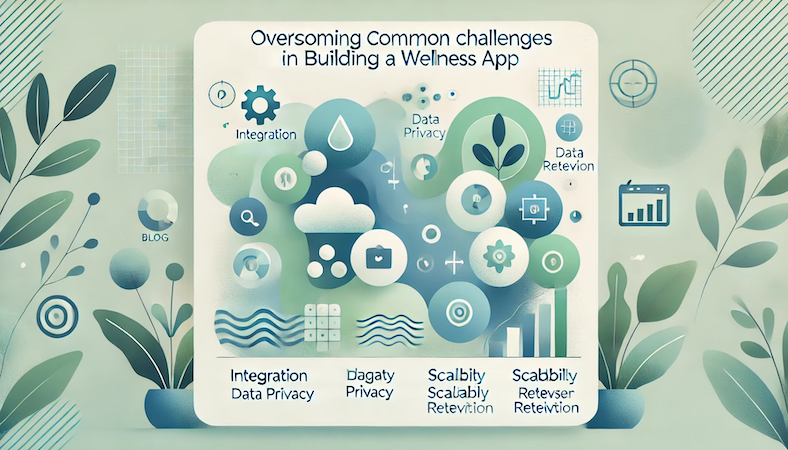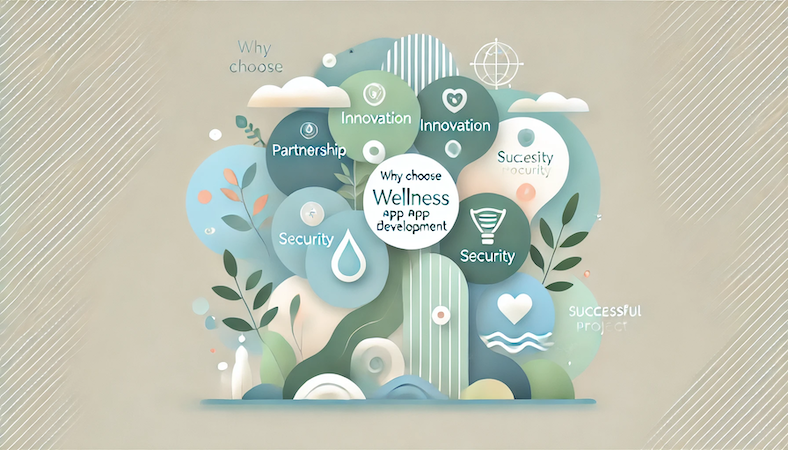Another blog on wellness app development? We get it. You’ve probably seen countless articles promising “insights” only to regurgitate the same surface-level tips: “focus on user experience,” “don’t forget security,” and—of course—“innovation is key.” But let’s be real: you don’t have time for fluff. You need actionable strategies, not a lecture on why wellness is important.
Here’s a stat that should raise your eyebrows: The global wellness app market is projected to hit $26.19 billion by 2030, nearly doubling in size. That’s a lot of noise—and an even bigger opportunity to stand out. But success isn’t about being first; it’s about being right. Right features. Right integrations. Right approach to privacy and compliance.
This isn’t just another generic guide. It’s a candid, no-nonsense deep dive into what it actually takes to build a successful wellness app—straight from a team that’s built multiple successful wellness platforms and navigated these challenges firsthand.
Key Takeaways:
- Choosing the right wellness app development company can make or break your project.
Proven expertise in healthtech and AI integration isn’t just a nice-to-have—it’s the difference between an app that scales and one that crashes under user demand. Companies like Topflight accelerate development with pre-built, HIPAA-compliant components, saving time and cutting costs.
- Health and wellness app development isn’t about building features—it’s about solving real-world problems.
Integrating with wearables, ensuring airtight data security, and designing for scalability are no longer competitive advantages—they’re baseline requirements. Companies that align tech choices with user needs and compliance from day one set themselves up for long-term success.
- Developing a wellness app is an investment—optimize for ROI, not just launch speed.
Rapid prototyping, MVP planning, and post-launch maintenance aren’t just phases—they’re strategic steps to avoid expensive rework. Focusing on modular architectures and flexible tech stacks ensures your app can grow with user demands and regulatory shifts.
Table of Contents:
- What is Wellness App Development?
- Types of Wellness Apps
- Key Features of a Successful Wellness App
- Wellness App Development Process
- Cost of Developing a Wellness App
- Overcoming Common Challenges in Building a Wellness App
- Why Choose Topflight for Your Wellness App Development?
What is Wellness App Development?
If you rewind a decade, “wellness” in tech was mostly about counting steps and basic calorie trackers. Fast forward to today, and wellness apps are no longer confined to fitness buffs or weekend yogis.
They’ve evolved into essential tools across digital health, catering to both personal users striving for better habits and corporate environments looking to reduce healthcare costs while boosting employee productivity.
Understanding the Landscape of Wellness Apps
In the industry landscape, we see a shift where wellness apps bridge the gap between preventive healthcare and everyday lifestyle management. Companies now use these apps to provide holistic programs—blending mental health support, physical activity tracking, and nutrition planning—tailored for diverse user bases.
For corporate wellness programs, these applications aren’t just perks; they’re strategic investments tied to measurable ROI. On the personal side, users demand hyper-personalized experiences that adapt to their routines, preferences, and even biometric data.
To provide a clearer picture of the wellness app industry’s rapid growth, consider these recent statistics:
- Market Expansion: The global wellness apps market was valued at approximately $11.27 billion in 2024 and is projected to reach around $26.19 billion by 2030, growing at a compound annual growth rate (CAGR) of 14.9%.
- User Engagement: In 2023, over 50 million individuals utilized wellness apps, highlighting their integration into daily health routines.
- Regional Insights: North America led the market, accounting for $355 million of the total revenue in 2023, reflecting a strong adoption rate in the region.
This evolution didn’t happen in a vacuum. Advances in digital health technologies, increased awareness of mental and physical wellness, and a global push toward remote healthcare solutions (especially post-pandemic) have all contributed.
Companies like ours have witnessed firsthand how the line between wellness and healthcare apps continues to blur, making strategic planning and precise execution more crucial than ever.
Key Benefits of Developing a Wellness App
Investing in wellness app development isn’t just about riding a trend—it’s about solving real, pressing issues in healthcare and workplace environments. Here’s why organizations are prioritizing these applications:
1. Enhanced Patient Care & Preventive Health
Wellness apps enable early detection and continuous health monitoring, reducing hospital visits and enabling providers to intervene before conditions escalate. For individuals managing chronic illnesses or mental health concerns, real-time data and personalized recommendations significantly improve adherence to care plans.
2. Operational Efficiency for Corporate Programs
Corporate wellness initiatives benefit immensely from these apps, which automate manual health-tracking processes, aggregate employee data, and provide actionable insights. This streamlines HR operations while promoting healthier lifestyles, ultimately reducing sick days and insurance costs.
Take a look at how these digital wellness solutions work in action: Our work on Walker Tracker is a prime example of how a well-designed wellness app can streamline corporate wellness initiatives, improve employee engagement, and reduce healthcare costs through effective activity tracking and data-driven insights.
3. Cost-Saving Opportunities & Long-Term ROI
Healthcare providers and organizations deploying wellness apps can lower patient readmission rates, optimize resource allocation, and minimize administrative overhead. On the personal side, users value apps that prevent costly medical interventions through proactive care.
4. Competitive Edge in the Digital Health Market
Companies developing robust wellness applications tap into a growing user base increasingly focused on self-care and longevity. With the digital health market projected to surpass $500 billion globally in the next few years, the potential upside is substantial.
For organizations considering entering this space, partnering with an experienced healthcare app development company like Topflight ensures that your application isn’t just another wellness app—it’s a tailored solution built for scalability, compliance, and meaningful impact.
Types of Wellness Apps
Wellness apps have come a long way from simple step counters. Today’s solutions cater to diverse aspects of well-being, ranging from physical health to mental clarity and balanced nutrition.
Understanding the different types of wellness apps is essential to identifying which solution aligns with user needs and business goals. Below are the key categories you should consider when planning your app development strategy:
Fitness and Activity Tracking Apps
These apps help users monitor workouts, steps, and calorie burns, integrating with wearable devices for real-time feedback. With demand surging for data-driven health solutions, companies aiming to build a fitness app should focus on seamless device integration and personalized goal-setting features to improve engagement and retention.
Mental Health and Meditation Apps
As awareness around mental health grows, apps offering meditation, stress management, and cognitive-behavioral support have become indispensable. Features like guided meditations, mood tracking, and AI-powered chatbots cater to users seeking self wellness solutions. Personalization and privacy safeguards are key to earning user trust in this sensitive area.
Related: Build a Mental Health App with Specode
Nutrition and Diet Planning Apps
Apps focused on nutrition enable users to track meals, manage calorie intake, and receive customized meal plans. Leveraging machine learning algorithms, these apps can offer meal suggestions based on user preferences, allergies, and lifestyle goals. Features like barcode scanning and integration with fitness trackers enhance the overall user experience.
Also Read: Nutrition App Development Guide
Corporate Wellness Apps
Designed for organizations aiming to boost employee well-being, corporate wellness apps provide fitness challenges, mental health resources, and health tracking dashboards. These solutions not only improve employee engagement but also reduce healthcare costs and absenteeism.
Companies investing in these apps should prioritize scalability and data security, ensuring smooth integration with existing HR systems and compliance with privacy regulations.
Key Features of a Successful Wellness App
Creating a wellness app that users actually stick with is about more than a sleek design or the latest tech buzzwords. It’s about understanding what genuinely drives engagement and crafting a solution that aligns with users’ goals, lifestyle needs, and expectations for data privacy.
Below are the key features that separate successful wellness apps from the ones users download, try once, and forget.
Personalization and User Engagement
No two users are the same—and your app shouldn’t treat them like they are. Personalization is crucial for sustaining long-term user experience and engagement.
Think dynamic dashboards that adapt to user preferences, customized workout or meal plans, and AI-driven content suggestions. For example, a wellness app could tailor daily step goals based on a user’s previous activity levels or recommend breathing exercises during high-stress periods.
In-app gamification (like streaks and achievement badges) can also encourage users to stay on track with their wellness goals. But don’t just throw in gamification for the sake of it—tie it to meaningful metrics that reflect actual health improvements.
Integration with Wearable Devices and IoT
Today’s users expect their wellness apps to sync seamlessly with wearable devices like smartwatches, fitness bands, and even connected scales. Beyond basic tracking of steps and heart rate, consider deeper integration with devices that monitor various aspects of well-being:
- Sleep Quality: Track sleep stages and provide personalized improvement tips.
- Stress Levels: Use wearable sensors to detect stress patterns and suggest calming activities.
- Blood Oxygen Saturation: Help users monitor their respiratory health, especially important for those with chronic conditions.
- Heart Rate Variability: Offer insights into recovery status and overall physical wellness.
- Smart Scales and Blood Pressure Monitors: Enable comprehensive health information collection for holistic analysis.
From a technical standpoint, implementing APIs for major platforms like Apple HealthKit and Google Fit should be prioritized to ensure seamless integration and interoperability. Real-time syncing isn’t just a “nice to have”—delays in tracking can seriously undermine user trust and engagement.
Data Security and Compliance Considerations
Wellness apps deal with sensitive data—from physical activity logs to mental health assessments. Ignoring data security isn’t just risky—it’s a lawsuit waiting to happen. At a minimum, implement end-to-end encryption, secure authentication protocols (think biometric logins), and clear data usage policies.
Compliance isn’t optional either. Depending on your target market, your app may need to comply with regulations like HIPAA (for U.S. users) or GDPR (in the EU). This is especially critical if your app handles data related to medical diagnostics or integrates with electronic health records.
At Topflight, we often advise clients to involve compliance experts early in the development cycle rather than retrofitting security features later—it’s faster, cheaper, and infinitely less stressful.
If you’re wondering how to create a mental health app that respects user privacy while delivering actionable insights, prioritizing compliance from day one is non-negotiable.
Leveraging AI and Machine Learning to Improve User Experience
Artificial intelligence (AI) and machine learning (ML) aren’t just tech jargon—they’re powerful tools for enhancing user experience and delivering hyper-personalized recommendations. Here’s how they can elevate wellness apps:
- Predictive Analytics: Anticipate when users might skip workouts and offer motivational prompts.
- Dynamic Goal Adjustment: Modify wellness goals in real time based on user progress and biometric data.
- Smart Nutritional Guidance: Analyze dietary information to recommend healthier meal options.
- Injury Prevention: Use tracking data to detect potential physical strain and suggest recovery plans.
- Mental Health Insights: Identify mood patterns through passive data collection and recommend coping strategies.
Remember, AI is only as good as the data it’s fed. Ensure robust data pipelines and quality checks are in place to deliver accurate, relevant, and beneficial insights—without bombarding users with irrelevant notifications. The goal is to enhance, not overwhelm.
Wellness App Development Process
Building a wellness app isn’t just about coding an MVP and hoping for the best. There’s a structured, iterative process that ensures you don’t end up with a flashy interface that users abandon after a week.
The key? A disciplined approach that aligns user needs, technical feasibility, and long-term ROI. Below, we break down the wellness app development process into five essential steps, pulling from our experience developing health and wellness solutions that don’t just launch—they thrive.
| Step | Description |
| Step 1: Define Goals and Target Audience | Align app goals with user needs, define target audience, and set measurable objectives. |
| Step 2: Choose the Right Technology Stack and Tools | Select appropriate mobile platforms, backend services, security layers, and wearable integrations. |
| Step 3: Design for Scalability and Compliance | Prioritize scalability, HIPAA compliance, EHR integration, and data privacy from the start. |
| Step 4: Develop and Test Your App | Use agile development, continuous testing, and real-user feedback for iterative improvements. |
| Step 5: Launch, Market, and Maintain Your App | Plan for a soft launch, marketing strategies, analytics tracking, and regular maintenance. |
Step 1: Define Goals and Target Audience
Imagine setting off on a road trip with no destination or map. That’s what diving into development without clear goals feels like—and spoiler: it doesn’t end well. The first step is understanding who you’re building for and why.
Are you targeting corporate clients looking to reduce healthcare costs or individuals seeking self-care tools? Knowing your audience shapes everything—from features to user experience. Equally important is defining measurable goals. Is the aim to improve user retention by 20% within six months? Or to integrate with wearables for real-time activity tracking? Clear objectives steer the project toward success, not scope creep.
Step 2: Choose the Right Technology Stack and Tools
Choosing the right tech stack is like choosing the right ingredients for a recipe—get it wrong, and the whole dish falls apart. For health and wellness app development, your tech choices impact scalability, security, and user experience.
- Frontend: Flutter or React Native can speed up development for both iOS and Android, saving time and costs.
- Backend: Node.js or Python (Django) offer scalability, especially if you’re incorporating machine learning capabilities.
- Databases: Opt for secure and scalable options like PostgreSQL or MongoDB, with encryption at rest.
- Security Layers: End-to-end encryption, OAuth 2.0 for authentication, and secure data storage are non-negotiable.
- Wearable Integration: Leverage APIs like Apple HealthKit or Google Fit to sync health data in real-time.
Selecting a robust tech stack ensures your app isn’t just built—it’s built to last.
Selecting the right tech stack is only part of the equation—partnering with experienced developers who follow industry best practices is equally critical. Developers should be well-versed in mobile app architecture, security protocols, and efficient coding standards to avoid technical debt.
Best practices like code reviews, modular development, and thorough documentation not only streamline the wellness app development process but also ensure long-term maintainability and scalability. Prioritizing developer expertise upfront can prevent costly rework later.
Step 3: Design for Scalability and Compliance
No one wants to rewrite code six months after launch because the user base doubled and everything broke. That’s why designing for scalability and compliance should be baked in from day one.
- Scalability: Use microservices architecture to manage different app components independently. This allows for easier feature updates without crashing the entire app.
- Compliance: If you’re targeting U.S. markets, HIPAA compliance isn’t optional—it’s mandatory. That means encrypting health data both in transit and at rest, securing user authentication, and maintaining audit trails. Planning to integrate with EHRs? Be prepared for interoperability hurdles and choose HL7 or FHIR protocols to ensure smooth data exchange.
- Data Privacy: Beyond compliance, be transparent with users about how their data is used. Clear privacy policies aren’t just for legal protection—they build user trust.
Failing to prioritize these aspects can lead to costly reworks and potential legal nightmares.
Step 4: Develop and Test Your App
Now comes the part where most teams rush—and regret later. Development and testing should be iterative, not linear. At Topflight, we use agile methodologies to ensure continuous feedback loops.
- Sprint Planning: Break features into manageable sprints. Prioritize core functionalities like user authentication, fitness tracker app development components, and essential integrations.
- Continuous Testing: Integrate automated testing early—waiting until the end leads to expensive, time-consuming bug fixes.
- Security Measures: Conduct penetration testing and vulnerability scans regularly. Data breaches in health apps aren’t just embarrassing—they’re lawsuit magnets.
- User Testing: Involve real users early and often. Their feedback on usability and features is invaluable for polishing the final product.
Remember, cutting corners here might get you to market faster but at the expense of long-term stability and user trust.
Step 5: Launch, Market, and Maintain Your App
You’ve launched—congrats! But if you think your job is done, think again. Post-launch is where many apps either flourish or flounder.
- Soft Launch: Start with a limited user base to catch unforeseen issues before a full rollout.
- Marketing Strategy: Targeted outreach is crucial. Use SEO, paid ads, and partnerships with corporate wellness programs to gain traction.
- Analytics & Feedback: Implement analytics to track user engagement, retention rates, and feature usage. Regularly reviewing these metrics helps refine and improve the app.
- Maintenance: Expect to push regular updates for bug fixes, feature enhancements, and compliance with evolving regulations. Think of it as ongoing care—just like wellness itself.
Investing in continuous improvement ensures your app remains relevant and valuable, avoiding the dreaded “install and uninstall” fate.
By following this wellness app development steps, you’re setting the foundation for a solution that’s not only functional but also secure, scalable, and genuinely useful to your target audience. Sure, it’s tempting to skip a few steps—but as anyone who’s had to rebuild a rushed product knows, doing it right the first time saves headaches (and dollars) down the road.
Cost of Developing a Wellness App
One of the first questions clients ask us at Topflight is, “How much will it cost?”—and honestly, there’s no one-size-fits-all answer. Developing a wellness app is like building a custom home: the final cost depends on size, complexity, materials (tech stack), and the craftsmanship (your development team).
Cutting corners can save you money upfront but will likely cost more in the long run—especially if you skimp on data security or compliance.
This section breaks down the factors influencing development cost and provides practical strategies to stretch your budget without sacrificing quality. After all, no one wants to spend six figures on an app that ends up collecting digital dust.
Factors Influencing Development Cost
When clients ask us about cost, we like to say: “It depends—because it really does.” Here are the main drivers that impact how much you’ll spend:
1. Features and Functionality:
- Basic apps with simple tracking and reminders cost less.
- Advanced features like AI-driven recommendations, real-time chat, or video consultations drive up complexity (and costs).
- Integrations with wearables or third-party services can add additional development hours.
2. Team Composition and Expertise:
- A seasoned team of developers, designers, and compliance experts will cost more but significantly reduce long-term technical debt.
- Hiring developers unfamiliar with healthcare compliance might seem cheaper until you face regulatory setbacks.
3. Compliance and Data Privacy:
- Handling sensitive health data means implementing HIPAA (for U.S.) or GDPR (for Europe) compliance—think encryption, secure logins, and audit trails.
- Compliance isn’t just a checkbox—it’s an ongoing cost, especially if you’re integrating with EHR systems.
4. Third-Party Integrations:
- Want your app to sync with Apple Health, Google Fit, or insurance platforms? Each API integration adds development hours.
- Payment processing or appointment scheduling integrations can also affect pricing.
5. Platform Choices (Mobile/Web):
- Developing separate mobile apps for iOS and Android doubles the work unless you use cross-platform solutions like Flutter.
- Web-based platforms, if required, will add to the total development cost.
Understanding these variables upfront helps you set realistic expectations and avoid sticker shock down the road.
Strategies to Optimize Your Budget
You want a top-tier wellness app without draining your entire budget—fair enough. Here’s how to keep costs in check without compromising quality:
1. Prioritize a Rapid Prototype Before the MVP
Before diving into building an MVP, start with a rapid prototype—it’s a faster, lower-cost way to validate your concept. This prototype can take the form of a clickable demo with zero code, allowing stakeholders and potential users to interact with the app’s flow and core screens without heavy development. Alternatively, it can be a light version of the app with a single core feature that demonstrates the main value proposition.
A well-validated prototype seamlessly transitions into an MVP, ensuring that when you do invest in development, it’s focused on features your target audience actually wants—saving time, money, and frustration.
2. Use Pre-built Components (Smart Shortcut Alert)
At Topflight, we’ve built (and implemented) ready-made HIPAA-compliant components that save clients significant time and money.
- Need secure chatting, video calling, appointment scheduling, or user onboarding? We’ve got you covered.
- These pre-built modules aren’t just budget-friendly—they’re tested, secure, and compliant, saving you months of development time.
3. Leverage Cross-Platform Development
- Using frameworks like Flutter or React Native allows you to develop one codebase for both iOS and Android.
- This reduces development time without sacrificing quality or user experience.
4. Engage Experienced Developers Early
- Trying to save by hiring less experienced teams often leads to costly rework.
- Experienced developers who follow best practices can spot potential pitfalls before they become expensive problems.
5. Plan for Post-Launch Costs:
- Budget for ongoing maintenance, compliance updates, and feature enhancements.
- Ignoring post-launch costs is a common mistake that leads to user attrition and technical debt.
What’s the Ballpark Cost?
- Basic Wellness App: ~$50,000 – $80,000
- Mid-Level (with wearable integrations and basic AI): ~$80,000 – $120,000
- Complex Solutions (real-time video, advanced analytics, EHR integration): $150,000+
These are rough estimates—your actual costs will vary depending on scope and complexity. But the biggest takeaway? Invest wisely in the areas that matter most: security, compliance, and user experience. Making a wellness app is a significant investment, but with the right approach (and partners), it’s one that can deliver substantial long-term ROI.
Overcoming Common Challenges in Building a Wellness App
Creating a wellness app isn’t just about having a great idea—it’s about navigating a complex web of technical hurdles, compliance requirements, and evolving user expectations. Even the most innovative concepts can fall flat if integration issues, data privacy concerns, or scalability problems aren’t addressed early.
Here’s how to tackle some of the most common challenges in wellness app development, drawing from our experience helping clients bring their healthtech solutions to market successfully.
Addressing Integration with Existing Health Systems
Seamlessly integrating with Electronic Health Records (EHR) or Electronic Medical Records (EMR) systems is one of the most significant hurdles wellness apps face. Many healthcare providers use outdated or proprietary systems, making interoperability a challenge.
To overcome this:
- Prioritize interoperability standards like FHIR and HL7 early in development.
- Use middleware solutions that bridge gaps between your app and legacy systems.
- Ensure robust data mapping and validation to prevent inconsistencies that could compromise patient care.
At Topflight, we’ve helped clients navigate these complexities by developing modular architectures that enable smooth integration without sacrificing performance. Bottom line: If your wellness app can’t talk to existing health systems, it risks being sidelined—so make integration a top priority.
Ensuring Data Privacy and Regulatory Compliance
When handling health data, privacy isn’t just important—it’s non-negotiable. Regulations like HIPAA (U.S.) and GDPR (EU) set strict standards for how user data should be collected, stored, and shared. Failing to comply can lead to hefty fines, loss of user trust, and legal consequences.
Here’s how to secure your app and ensure compliance:
- Implement end-to-end encryption for data both in transit and at rest.
- Use multi-factor authentication (MFA) to prevent unauthorized access.
- Maintain clear consent protocols and provide transparent data usage policies.
- Conduct regular audits and penetration testing to identify vulnerabilities.
We recommend involving compliance experts from day one rather than retrofitting solutions later—it’s faster, cheaper, and reduces risk. Compliance isn’t a one-time checklist; it’s an ongoing commitment to keeping users’ data safe.
Achieving Scalability and Longevity of Your Application
A common pitfall in wellness app development is focusing so heavily on the launch that long-term growth and maintenance get sidelined. But what happens when your user base doubles overnight? If your architecture isn’t built to scale, you’ll face slow load times, crashes, and frustrated users—guaranteed ways to lose traction in a competitive market.
To ensure your app remains robust as it grows:
- Adopt a microservices architecture: It allows individual components to scale independently without affecting overall performance.
- Use cloud-based solutions like AWS or Google Cloud for elastic scaling capabilities.
- Monitor performance metrics in real time to identify and address bottlenecks quickly.
- Plan for regular updates to keep up with evolving compliance standards and user expectations.
Technical debt is the silent killer of longevity. Investing upfront in scalable architecture and best practices prevents the costly rework that often arises from taking shortcuts early in development. At Topflight, we emphasize future-proofing from day one—because maintaining an app is just as important as building it.
Why Choose Topflight for Your Wellness App Development?
Choosing the right wellness app development company for this journey can make or break your project. At Topflight, we don’t just build apps—we create secure, scalable solutions tailored to your business needs. Our team blends deep healthtech expertise with innovative, AI-driven technologies to ensure your app delivers measurable ROI.
Proven Expertise in HealthTech and AI Integration
We’ve successfully partnered with leading companies to bring cutting-edge wellness solutions to market. Case in point:
- Walker Tracker: We transformed a struggling wellness platform from a 2.6-star app into a 4.6-star success, integrating wearable device connectivity and improving scalability, which led to its acquisition by Terryberry.
- Allheartz: By leveraging AI-powered pose detection and real-time data analysis, we developed an innovative physiotherapy app that cut in-person patient visits by up to 50% and reduced clerical work by 80%.
- Habitap: We helped launch a habit-building fitness app designed to boost user engagement through personalized challenges, seamless wearable integration, and a scalable architecture that supports long-term growth.
Commitment to Compliance and Data Security
Healthcare apps deal with sensitive user data—compliance isn’t optional. Our team prioritizes HIPAA-compliant architectures, secure authentication protocols, and rigorous data privacy measures to keep both your business and users protected.
Focus on Delivering ROI and Scalable Solutions
We don’t just focus on launching your app; we ensure it grows with you. Whether you’re starting with an MVP or scaling to accommodate thousands of users, our flexible development models are designed to maximize long-term value.
Let’s Build Something Exceptional Together
Ready to create a secure, scalable solution through expert health and wellness app development that delivers real value to your users? Book a free consultation with us today, and let’s discuss how Topflight can help turn your vision into reality.
Frequently Asked Questions
How long does it typically take to develop a wellness app?
Depending on complexity, a basic MVP can take 3-6 months, while more feature-rich apps with integrations and AI components may require 9-12 months. That said, we can get you up and running with a rapid prototype in as little as a month, giving you a fast, tangible way to validate your concept and gather early feedback.
Can wellness apps be monetized beyond subscriptions?
Yes. Systems with embedded AI, patient portals, and remote monitoring tools have been shown to increase engagement by 30% or more, according to recent HIMSS data.
How do you ensure a wellness app complies with HIPAA and GDPR?
They are either fully migrated, archived for reference, or kept in hybrid models where legacy data remains accessible while new records are created in the upgraded system.
Is integrating wearables like Apple Watch and Fitbit really worth the effort?
Absolutely. Wearable integration boosts user engagement and retention by providing real-time health data, which users increasingly expect as standard.
How do you prevent your wellness app from becoming just another download and delete?
Prioritize personalization, continuous user feedback, and features that deliver genuine value—like adaptive goal setting and proactive health insights.
